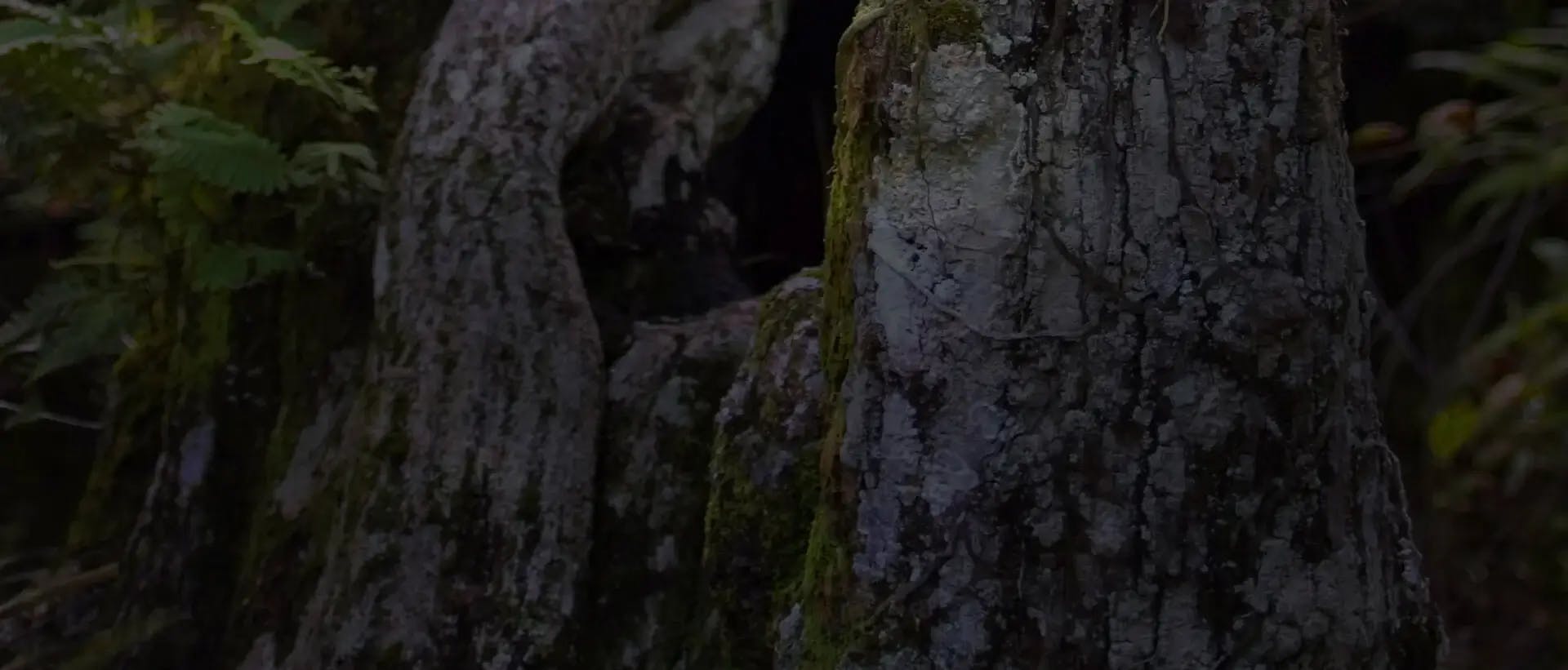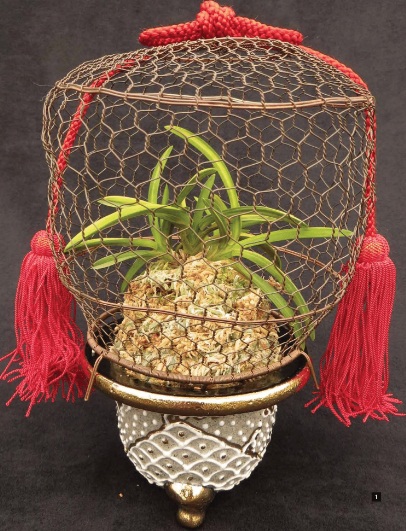

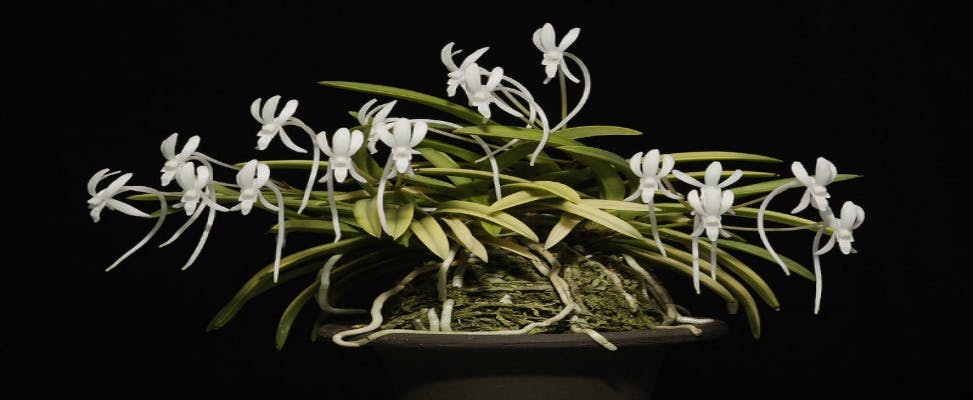
Neofinetia falcata - Not Just Another Pretty Face

American Orchid Society, July 30, 2015
YOU MAY KNOW the quote, "My kingdom for a horse!" but what about a kingdom for an orchid? May be not a kingdom, but would you settle for a large estate? In the Edo period in Japan, approximately 400 years ago, there was one species of orchid that garnered such reverence that the presentation of a particularly fine specimen to the local elite — shoguns and samurai — could mean being granted your own estate. Neofinetia falcata, or "samurai orchids" were in fact, so esteemed that only those of the ruling class were permitted to own them. When viewing the shogun's plants, people were forbidden to breathe on the plants lest they contaminate the plants with their gems. For protection, the plants were often covered with screens and admirers were required to cover their mouths with paper when near a plant.
The easiest way to understand what makes Neofinetia falcata or "Neos" so special is to explain how they are not like other orchids. Typically, the word orchid conjures images of showy flowers with magnificent shapes and colors. What we generally do not picture is the plant that makes those flowers. For most orchid admirers, the plant itself is merely a vehicle for producing much anticipated blooms — sometimes anticipated for years! In the meantime, one plant looks almost identical to other plants of the same genus or species. For example, I recently received a shipment of cattleya hybrids, and the only feature differentiating one variety from the next was the tag. And then there is Neofinetia falcata, commonly called "fuuran" (wind orchid) in Japan. The most beautiful or unusual of the fuuran are called "fuukiran," which translates as "rich and noble orchids" because they were historically only owned by the samurai and people of similar rank. Neo flowers, too, are beautiful and incredibly fragrant, but they are not usually the prized feature for collectors. Neos, which are epiphytes native to Japan, China and Korea, are remarkable for their foliage, which makes them unusual in the orchid world. There is no need to wait to enjoy Neof. falcata it is always on display. With over 2,200 varieties described, it is fair to say that these plants come in all shapes and sizes from tiny Kuroshinju, whose dwarf-sized growths measure only about an inch (2cm) across, to Kyokushou, whose "tiger" leaves spread over 7 inches (17.5 cm).
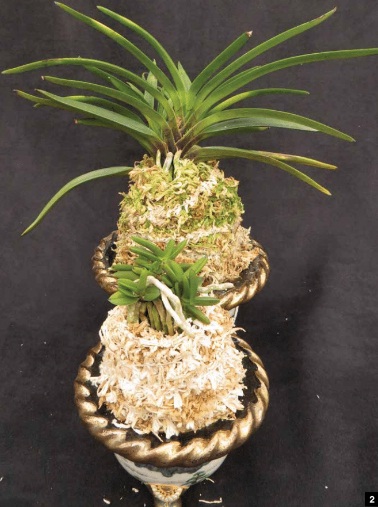
[1] Neofinetia (Vanda) falcata, Taiyoden with a traditional screen meant to protect prized plants from damage.
[2] Contrast in size: tiny Neofinetia falcata 'Kuroshinju' is dwarfed by Neofinetia falcata 'kyokushou' although they are the members of the same species—evidence of the power of mutation.
Those new to Neof. falcata should take time to study its unique features and gain a real appreciation for the subtleties of the plant. While we all admire beautiful flowers, newcomers to Neos need time to recognize the beauty inherent to orchid plant themselves. One can appreciate fuukiran like a fine black and white photograph: the richness lies in the depths of tone and composition. It is helpful to know the characteristics that give this species its rich and noble history. With a little guidance, you can see the finer characteristics that the samurai recognized in this special orchid.
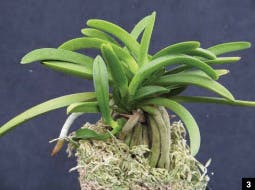
[3] Neofinetia falcata fuuran is the most common of the wind orchids and is considered the average against which other varieties are compared.
[4-6] Striping variegation in Neofinetia falcata: (4) 'Miyako Habutae' shows beautiful marginal striping that is consistent among the leaves. Notice the younger growth has not fully developed the same patterns; (5) 'Kishyushirayuki' Tiger unevenness describes horizontal bands of yellow to white coloration. In breeding among Neo varieties, only tiger coloration consistently breeds true; (6) 'Furin' shows a combination of variegation types including shima and tiger unevenness. Newer growths also exhibit Ku Rhy Den or "fire from the mouth of the dragon" which describes entirely yellow (or nearly so) new growths. Some consider Ku Rhy Den undesirable in a growth as leaves lack chloroplasts that are necessary for photosynthesis.

[3] Neofinetia falcata fuuran is the most common of the wind orchids and is considered the average against which other varieties are compared.
[4-6] Striping variegation in Neofinetia falcata: (4) 'Miyako Habutae' shows beautiful marginal striping that is consistent among the leaves. Notice the younger growth has not fully developed the same patterns; (5) 'Kishyushirayuki' Tiger unevenness describes horizontal bands of yellow to white coloration. In breeding among Neo varieties, only tiger coloration consistently breeds true; (6) 'Furin' shows a combination of variegation types including shima and tiger unevenness. Newer growths also exhibit Ku Rhy Den or "fire from the mouth of the dragon" which describes entirely yellow (or nearly so) new growths. Some consider Ku Rhy Den undesirable in a growth as leaves lack chloroplasts that are necessary for photosynthesis.
LEAFT TYPES for a non blooming plant, this is the feature that one notices first, and the Japanese have a specific name for each characteristic of the leaf. Aside from different colors and shapes, there are sometimes unusual textures as well, such as "raspy" (yasuri), and "rough textured" (kinginrasha); for the sake of brevity these will not be discussed here.
Normal (namiba). These plants appeared to be miniature Vanda plants with long, narrow darken-green leaves that are slightly creased lengthwise. The common fuuran, the standard for Neof. falcata, is the most readily available and least expensive variety of the species. The leaves are average size for a Neo and lack variegation. Compare this variety's leaves with other leaf type, and you gain a sense of the variation within this species.
Variegated. Most variegated Neofinetia have the normal leaf shape, as described above. The variegation is named based on the appearance in or on the leaf. These are more readily available variegations.
Hukahukur. The leaf has a white to yellow edge with a green center.
Nakasuke. The leaf has a green edge with white to yellow center.
Shima. The leaf has alternating strips of white/yellow and green lengthwise across the leaf.
Torahan. The leaf has alternating strips of white/yellow and green horizontally across the leaf.
Tiger coloration. Leaves have horizontal bars of white/yellow coloration. In Neo breeding, only tiger coloration has been demonstrated to pass faithfully from parent to offspring.
Another unusual characteristic of Neofinetia with regard to variegation is the species' ability to "morph" to a significantly different striping pattern. Because the color pattern is the characteristic that identifies some of the varieties of Neofinetia, a morphing plant is two varieties at one time, which greatly increases its value. If you divided the plant, you would have two different plants with two different names. For example Nishidemiyako sometimes morphs into Manazuru. Both are shima but distinctly different. Once formed, the Manazuru portion of the plant would continue to make new Manazuru offshoots while the Nishidemiyako portion would continue to make (mostly) Nishidemiyako offshoots. The mechanism controlling this phenomenon has not been described in English, but may be described in non-English-speaking journals. Simple mutation cannot account for morphing because those varieties that morph always morph to the same variety. My hypothesis is that there is a "switch" on an important color-controlling gene that occasionally gets switched on or off resulting in the different, but predictable, morphed growth.

[7] Nishidemiyako "morphing" to 'Manazuru' although better described as "mutating" the new growth on this plant has a striping pattern that is opposite of its parent growth. In this way, the plant is two varieties at one time and demonstrates one of the more interesting character of this species.
[8] Neofinetia falcata 'Senzai' is an example of bean leaf neo which has a smaller length to width ratio than the average Neo.
Leaf shapes. Mutations have also resulted in interesting leaf shapes besides the typical strap-shaped leaves. Some of the most common leaf shape variations are:
♦ Bean (mameba). Leaves are shorter and thicker than average, the smallest being less than 4/10-inch (1-cm) long. Bean leaf Neofinetia are usually dark green in color, but there are rare plants that are variegated. A single-growth variegated bean leaf plant may fetch well over $10,000. Because shima-type variegation is not passed to the next generation, these little gems cannot be produced simply by crossing a bean-leaf plant with a shima plant.
♦ Pine needle (hariba). Leaves are long and narrow giving growths the appearance of pine boughs. A fully grown pine needle Neofinetia can have leaves that are about 3–3½ inches (7.5–9 cm) in length. Sadly, some of these varieties do not flower at all, which discourage some people from growing them. Once you admire a full-grown specimen, however, lack of flowering may not concern you.
♦ Twisted (kuruiba). These plants display an interestingly untidy appearance where growths mingle with each other. Many of these varieties have descriptive name like "dragon tail." Although these leaves may also be rather pointy, the contorted varieties are good bloomers as well.

[9] Neofinetia falcata 'Yoroidoushi' exhibits interesting pine needle growths that are fast-growing, but difficult to induce to bloom
[10] Neofinetia falcata 'Naniwajishi' does not have the distinctive fans of leaves that are typical of the species. Instead, the growths twist on their axis, making it difficult to distinguish one growth from another.
[11-12] Tsuke are generally crescent shaped, but some varieties have straight (not pictured) mountain or wave shaped. 'Kaiomaru' (11) has a distinctive mountain tsuke as well as dark purple coloration. Oonami Seikai (12) is characterized by a beautiful wave.
♦ Tsuke. This is a uniquely Japanese-defined plant characteristic that describes where the leaf attaches to the axis or center of the plant. There are four types of tsuke:
Crescent Moon (tsukigata). The most prevalent shape, the outline is shaped like a crescent moon.
Mountain (yamagata). The rarest tsuke, it has a bump, mountain like in the middle.
Wave (namigata). This tsuke is said to look like the ripples of the ocean as the waves meets the shore.
Straight (ichimonji). This tsuke is as described, a straight line.
FLOWERS The flowers of Neofinetia are usually white and very fragrant, smelling of vanilla, honeysuckle or orange blossoms. Plants typically bloom in late spring into summer, and flowers can last for weeks. In addition to the sepals, petals and lip, they also have a long nectar spur. There are some floral variants that are attractive to Neo collectors:
Color. Though most Neofinetia have white flowers, there are varieties of that produce green, yellow, pink, or dark pink (red) flowers or floral parts.
Morphological variants. Some flowers do not have any spur (e.g., Hoshiguruma) while others have additional spurs (e.g., Sobiryu). A highly desirable variety, Manjushage, has three or even four spurs. Shunkyuden has modified flower parts and a combination of white, pink and green that makes me think of giant clover.
Roots. While critical to the health of the plant, an epiphyte in the wild, collectors are more interested in the color of the root tips, which are visible when grown in baskets or when new roots grow outside their growing medium. Colors include bright green, brown or mud, pink and the most desirable, ruby red.
Only those varieties of Neof. falcata that display outstanding characters earn the title fuukiran, while more ordinary varieties remain simply fuuran. Every year the All Nippon Fuukiran Orchid Society publishes a beautifully designed Meikan, a chart that establishes the rank of every cultivated fuukiran recognized by the society. While there are over 2,200 varieties of Neof. falcata, only about 200 are registered on the Meikan. To be judged worthy of addition to the Meikan is a grand achievement. A committee from the Society judges submitted plants each year based on their intrinsic characteristics, uniqueness and presentation. Submission involves a large fee and the presentation of three plants of the variety to be judged mounted in suitably beautiful pots lest the judge refuse to look at the plants at all. Mounting a Neofinetia is an art unto itself as it involves draping strands of moss around the orchid's root ball to create a smooth, hollow mound that elevates the plant above the pot, showing it off to best effect. In addition, the pot chosen for display must be judged to be suitably matched to the plant to be evaluated. Even Neofinetia pots are extraordinary. Traditionally, they are fired-clay pots with three feet and a large drainage hole in the bottom. The finest pots are hand painted with intricate illustrations of landscapes, dragons, fish or birds, and these are individually signed by the artist. A mature Neo family mounted in a traditional pot is nothing less than a work of art.

One of the reactions common to people who are not familiar with Neos is sticker shock. I understand this: it is often a small plant with a large price tag. Why is that? First remember that you are not buying a plant based on size, but rather on its merit. After that, it all boils down to supply and demand both here and in Asia. Unlike most orchids, some of the most desirable varieties of fuukiran are available only as divisions of larger plants. Fuukiden, the top ranked Neofinetia, cannot be crossed with another Fuukiden to make baby Fuukiden. Rather than having the gorgeous stripes characteristic of that variety, all the offspring will be solid green, barring mutations. Because the majority of the most desirable varieties are characterized by similar shima-type variegation, availability (and price) is determined in large part by how fast that variety produces new growths. In fact, many Neo varieties do not breed true to form, and collectors often ask if the plant they are buying is a division seedling.
Availability in the United States is determined by both availability in Asia and the process of importing, which is risky in terms of plant health, expensive and fraught with paperwork. Many growers in Taiwan and Hawaii have basic fuuran for sale, but the named Neo varieties are generally only available through Japanese and Korean growers. From year to year, availability of particular varieties changes and the price asked from the growers in Asia can change dramatically, which affects prices here.

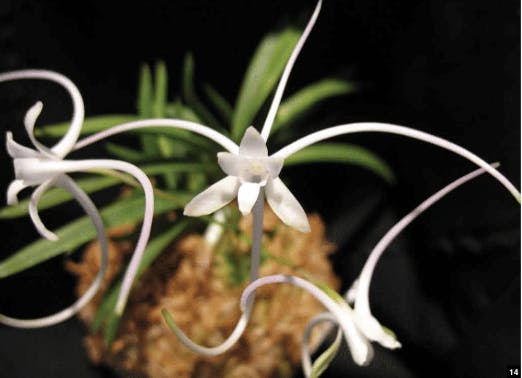

[13] Even without leaf variegation or colored flowers, wind orchids are magnificent to behold and to smell when they are in full bloom, generally during the summer.
[14] Most wind orchids have a single spur; however, 'Manjushage' is notable for having three. The plant pictured belongs to Therese Gorostiza and has four distinct spurs!
[15] Neofinetia falcata 'Benisuzume' is one of a number of furan that has a red or pink flower. The amount and distribution of red pigmentation differ among varieties and even individual plants.
CULTURE Despite their exclusive history, you do not need to be a samurai or even a professional orchid grower to raise Neos successfully; Neof. falcata is an ideal houseplant if you have a sunny window. They take up very little space even when they are very old, and they are rarely attacked by insect pests. They are certainly among the easiest of all orchids to grow at home.
Temperature. Given their native habitat, Neos can withstand near freezing temperatures in the winter and temperatures into the 90s F (32–37 C) in the heat of the summer. Temperature stress, however, will not maximize growth, so try to avoid extreme temperatures. Although, in their native habitat, fuuran may experience freezing temperatures, personal experience requires that I warn you against that. I grow my plants in a greenhouse from October into May, with night temperatures 55 F (12.8 C) and day temperatures of 65–75 F (18.3–23.9 C). For the rest of the year, I grow them outside under the shaded pergola. Indoor growers enjoy great success under lights (my patrons rave about T5 lights) or simply on a windowsill. Neos do not requires special temperature treatment to induce blooming; however, indoor growers do seem to get a jump on blooming, which suggests that warm temperatures in the spring may initiate flowering.

Light. While Neos can tolerate high light level, they look their best grown at intermediate to low light. Experience has shown that high levels light lead to lighter leaf color and smaller leaf span. Some growers will position their Neos so they are shaded by larger plants. The exceptions to this rule are the tiger varieties of Neos, many of which requires higher light levels to develop their stripes. For example, I bought a bunch of "tiger" plants (Setsuzan) this February that did not have a mark on them. Once in my greenhouse under moderate light level, they develop stripes, within a couple weeks. It is also possible to overexpose the plants, however, so I suggest starting your tigers at the same low-medium light levels as the rest of your Neos. If you do not see color developing, or you see color fading, increase the light intensity. Plants that have red and purple coloration on their leaves require higher light levels to maintain the production of the flavonoids (plant pigments) responsible for colors. Some varieties not characterized by a pink blush on the leaves may develop some pink in the high light. This can beginning of the sun damage, so do not be taken in by pretty colors.
Water and fertilizer. The most important rule of Neo growing is to allow the plants to dry completely before watering. Many orchids, including Neofinetias have the same special adaption as cacti and succulents (CAM photosynthesis) that make them well suited for drier environments. As with cacti, the worst thing you can do is over water your plants. Allow that rule to determine your best option for potting and medium (discussed below). the good news is that, for those of us without misters and humidifiers, Neos are perfectly happy.
Neos are not heavy feeders. Use a weak fertilizer solution weekly during the warmer months, and reduce feedings to only once a month during the winter. Many growers find that slow-release fertilizer pellets work very well for these plants.

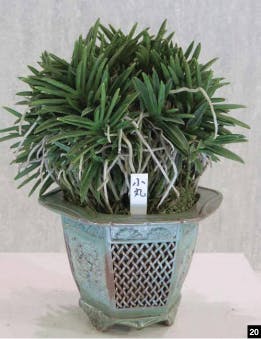
[16, 17, 19] Root tip colors vary among wind orchids with ruby roots being the most prized. 'Houmeiden' (16) is one of a number of varieties noted for its ruby root tips. This 'Suruga Fukurin' (17) has a new green root tip pooping out of its moss. 'Suikaden' (19), here mounted on a bark slab like a proper epiphyte, exhibits "mud" root tips which are something between dark red and brown.
[18] 'Kishu Ryokufu' clearly shows how red pigmentation also creates interesting leaf patterns. As with other color variegations, the strength of coloration is dependent on sufficient light availability.
[20] This 'Komaru' won the blue ribbon for its class at the Japan Grand Prix Orchid Festival in February 2014. Note the exceptional size and shape of the plant as well as the beautiful pot.
Pots and medium. I am not trying to be evasive in saying that you can use whatever pots and medium you like to grow fuuran. Almost anything you can think of is working for someone out there! All the growers in Japan that I know of use New Zealand sphagnum moss and clay pots. Moss, when it is not over packed provides both humidity and air circulation around the roots. Remember that the big mound of sphagnum you see under a formally mounted Neo is hollow. The ball is formed around a bottle or an inverted pot to create a large air pocket for the roots' health. For my plants I use a light wrapping of sphagnum around the roots and tuck the plant into a plastic net pot to ensure excellent air movement around the roots. Typically, plants in sphagnum are repotted every year to maintain the integrity of the moss.
If you are a classic overwater, however, you may want to avoid moss and use a bark mix or even mount your plant on cork or place in a basket. Last year, during a particularly cool and rainy week, I stripped the moss off of a number of plants to prevent rot. As an experiment, I left some of them "naked" in closed -sided plastic pots. They have been growing beautifully, even if the presentation is not aesthetically pleasing.
As the plant family with the largest number of species, orchids offer growers a diverse assortment of beautiful forms and flowers. While most orchid lovers have concentrated their attention on flowers that are sometimes elusive and always temporary, Neofinetia falcata offers more by providing year-round visual interest in addition to a history that is as rich as noble as the plant itself. I invite you to spend a few moments up close and personal with a samurai orchid to enjoy its fine qualities.
Acknowledgments:
I would like to thank Dr. Glenn Lehr, Jasson Fisher and Dr. Thomas Mulhollan for information that contributed to this article. I would also like to thank Stephane Pissivin and Therese Geostiza for the contribution of their photographs.
—Dr. Kristen Uthus is the owner of New World Orchids (www.newworldorchids.com) in Manchester, Michigan, USA, where she specializes in the cultivation of Japanese orchids. She is much in demand for her entertaining presentations. With a background in plant ecology and evolution, she was a lecturer in biology and ecology at several universities and colleges prior to purchase New World Orchids.

FREE ACCESS: Orchid DealWire
Get notified when orchid vendors have special promotions and exclusive savings.
